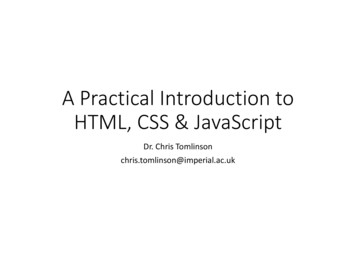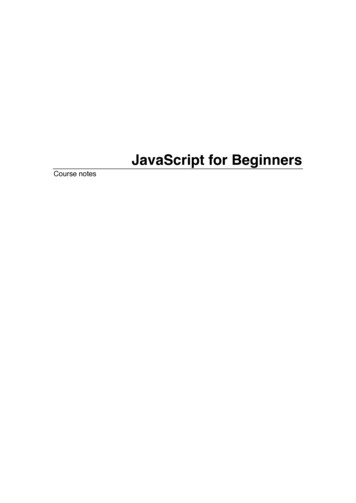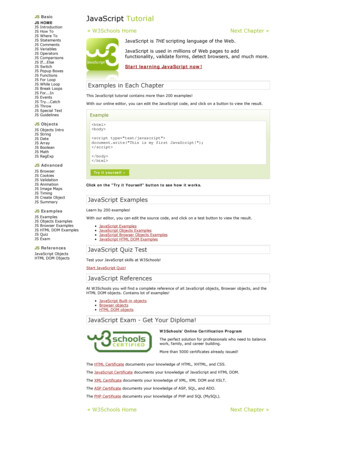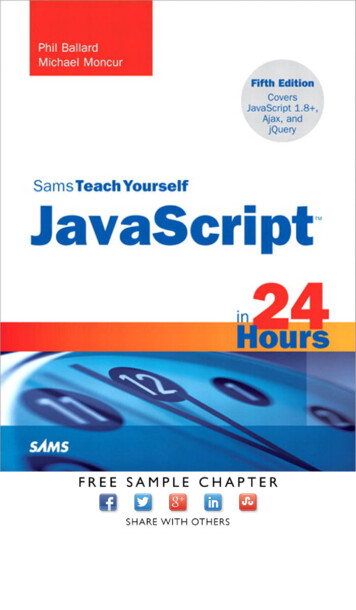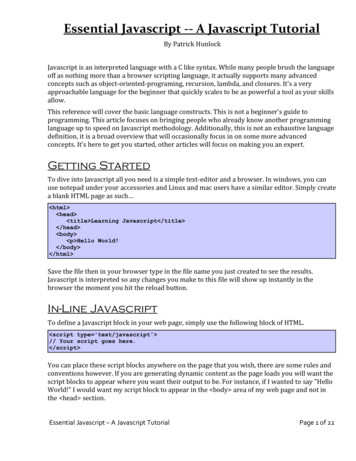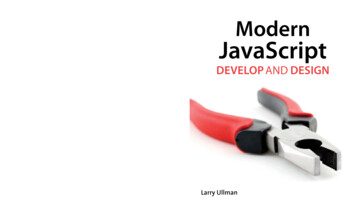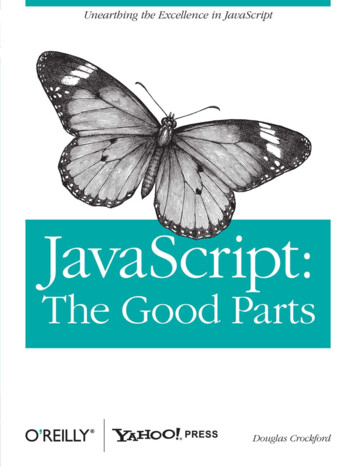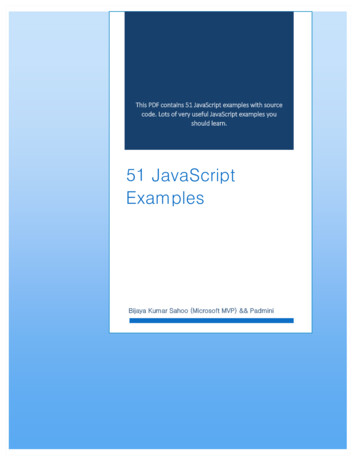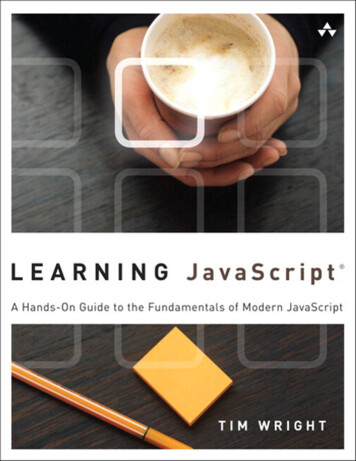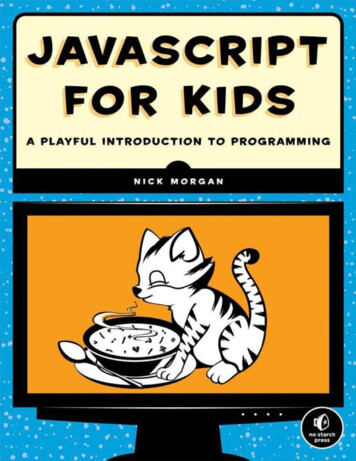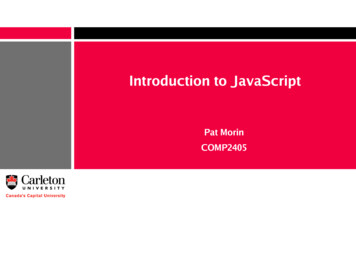
Transcription
Introduction to JavaScriptPat MorinCOMP2405
Outline What is JavaScript?– History– Uses Adding JavaScript to HTML JavaScript syntax JavaScript events JavaScript classes The HTML Document Object Model2
What is JavaScript? JavaScript is a programming language for use inHTML pages Invented in 1995 at Netscape Corporation(LiveScript) JavaScript has nothing to do with Java JavaScript programs are run by an interpreter builtinto the user's web browser (not on the server)3
Where does JavaScript Fit In? Recall1. client opens connection to server2. client sends request to server3. server sends response to client4. client and server close connection What about Step 5?5. Client renders (displays) the response received from server Step 5 involves displaying HTML And running any JavaScript code within the HTML4
What can JavaScript Do? JavaScript can dynamically modify an HTML page JavaScript can react to user input JavaScript can validate user input JavaScript can be used to create cookies (yum!) JavaScript is a full-featured programming language JavaScript user interaction does not require anycommunication with the server5
Pros and Cons of JavaScript Pros:– Allows more dynamic HTML pages, even complete webapplications Cons:– Requires a JavaScript-enabled browser– Requires a client who trusts the server enough to run thecode the server provides JavaScript has some protection in place but canstill cause security problems for clients– Remember JavaScript was invented in 1995 and webbrowsers have changed a lot since then6
Using JavaScript in your HTML JavaScript can be inserted into documents byusing the SCRIPT tag html head title Hello World in JavaScript /title /head body script type "text/javascript" document.write("Hello World!"); /script /body /html 7
Where to Put your Scripts You can have any number of scripts Scripts can be placed in the HEAD or in the BODY– In the HEAD, scripts are run before the page is displayed– In the BODY, scripts are run as the page is displayed In the HEAD is the right place to define functionsand variables that are used by scripts within theBODY8
Using JavaScript in your HTML html head title Hello World in JavaScript /title script type "text/javascript" function helloWorld() {document.write("Hello World!");} /script /head body script type "text/javascript" helloWorld(); /script /body /html 9
External Scripts Scripts can also be loaded from an external file This is useful if you have a complicated script orset of subroutines that are used in several differentdocuments script src "myscript.js" /script 10
JavaScript Variables JavaScript has variables that you can declare withthe optional var keyword Variables declared within a function are local tothat function Variables declared outside of any function areglobal variablesvar myname "Pat Morin";11
JavaScript Operators and Constructs JavaScript has most of the operators we're used tofrom C/Java––––Arithmetic ( , - , *, /, %)Assignment ( , , - , * / , % , , --)Logical (&&, , !)Comparison ( , , , , ) Note: also does string concatentation Constructs:– if, else, while, for, switch, case12
Simple User Interaction There are three built-in methods of doing simpleuser interaction– alert(msg) alerts the user that something has happened– confirm(msg) asks the user to confirm (or cancel)something– prompt(msg, default) asks the user to enter some textalert("There's a monster on the wing!");confirm("Are you sure you want to do that?");prompt("Enter you name", "Adam");13
JavaScript Functions JavaScript lets you define functions using thefunction keyword Functions can return values using the returnkeywordfunction showConfirm() {confirm("Are you sure you want to do that?");}14
JavaScript Arrays JavaScript has arrays that are indexed starting at 0 Special version of for works with arrays script type "text/javascript" var colors new Array();colors[0] "red"; colors[1] "green";colors[2] "blue"; colors[3] "orange";colors[4] "magenta"; colors[5] "cyan";for (var i in colors) {document.write(" div style \"background-color:" colors[i] ";\" " colors[i] " /div \n");} /script 15
JavaScript Events JavaScript can be made to respond to user events Common Events:– onload and onunload : when a page is first visited or left– onfocus, onblur, onchange : events pertaining to formelements– onsubmit : when a form is submitted– onmouseover, onmouseout : for "menu effects" A complete list of event types is available here– http://www.w3schools.com/jsref/jsref events.asp16
Exception Handling JavaScript also has try, catch, and throwkeywords for handling JavaScript errorstry {runSomeCode();} catch(err) {var txt "There was an error on this page.\n\n" "Error description: " err.description "\n\n"alert(txt)}17
Comments in JavaScript Comments in JavaScript are delimited with // and /**/ as in Java and C 18
JavaScript Objects JavaScript is object-oriented and uses the samemethod-calling syntax as Java We have already seen this with the documentobjectdocument.write("Hello World!");19
Built-In JavaScript Objects Some basic objects are built-in to h20
JavaScript Strings A String object is created every time you use astring literal (just like in Java) Have many of the same methods as in Java– charAt, concat, indexOf, lastIndexOf, match, replace, search,slice, split, substr, substring, toLowerCase, toUpperCase,valueOf There are also some HTML specific methods– big, blink, bold, fixed, fontcolor, fontsize, italics, link, small,strike, sub, sup Don't use the HTML methods (use CSS instead)– This is the worst kind of visual formatting21
JavaScript Dates The Date class makes working with dates easier A new date is initialized with the current date Dates can be compared and incrementedvar myDate new Date();myDate.setFullYear(2007,2,14);var today new Date();var nextWeek today 7;if (nextWeek today) {alert("You have less than one week left");}22
JavaScript Arrays and Booleans We have already seen the Array class The Boolean class encapsulates a boolean value23
The JavaScript Math Class The Math class encapsulates many commonlyused mathematical entities and formulas These are all class methods– abs, acos, asin, atan, atan2, ceil, cos, exp, floor, log, max,min, pow, random, round, sin, sqrt, tan These are all class methods– E, LN2, LN10, LOG2E, LOG10E, PI, SQRT1 2, SQRT2if (Math.cos(Math.PI) ! 0) {alert("Something is wrong with Math.cos");}24
JavaScript and the DOM The Document Object Model (DOM) is aspecification that determines a mapping betweenprogramming language objects and the elementsof an HTML document Not specific to JavaScript25
HTML DOM Objects Environment objects– Window, Navigator, Screen, History, Location, Document HTML objects– Anchor, Area, Base, Body, Button, Event, Form, Frame,Frameset, Iframe, Image, Checkbox, FileUpload, Hidden,Password, Radio, Reset, Submit, Text, Link, Meta, Object,Option, Select, Style, Table, TableCell, TableRow, TextArea26
HTML DOM: Document The Document object represents an HTMLdocument and can be used to access alldocuments in a page A Document contains several collections– anchors, forms, images, links Has several properties– body, cookie, domain, lastModified, referrer, title, URL Has several useful methods– getElementById, getElementsByName,getElementsByTagName, write, writeln, open, close27
HTML DOM: Document An instance of Document is already created foryou, called documentfunction changeF() {var cText document.getElementById("c");var fText document.getElementById("f");.}. input type "text" id "c" onchange "changeC()" C input type "text" id "f" onchange "changeF()" F28
HTML DOM: Form Elements One of the most common uses of JavaScript is forform validation Several HTML DOM classes encapsulate formelements– Form, Button, Checkbox, Hidden, Password, Text, Radio,Reset, Submit, Textarea Warning: Using JavaScript is not a substitute forvalidating form data in CGI scripts29
HTML DOM: Text A text entry field (input type "text") isencapsulated by a Text object Variables– value, maxLength, id, size, name, tabindex, readOnly Changing these variables has an immediate effecton the displayed data30
HTML DOM: The Document Tree Accessing elements and changing their propertieslets us do simple things like form validation, datatransfer etc HTML DOM lets us do much more We can create, delete, and modify parts of theHTML document For this we need to understand the Document Tree31
HTML DOM: The Document Tree32
Navigating the Document Tree With JavaScript we can navigate the documenttree document.getElementById(),getElementsByName(), andgetElementsByTagName() return nodes in thedocument tree Information can be obtained from– nodeName – The tag name– nodeValue – The the text of a text node– nodeType – The kind of node33
34
What can JavaScript Do? JavaScript can dynamically modify an HTML page JavaScript can react to user input JavaScript can validate user input JavaScript can be used to create cookies (yum!) JavaScript is a full-featured programming language JavaScript user interaction does not require any communication with the server
